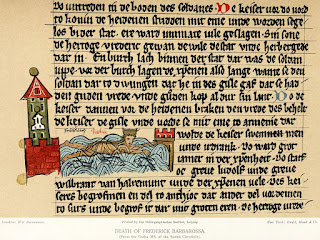Richard had made a couple approaches to Jerusalem, but was stymied first by horrible weather and then by disagreements among the leaders. He was also concerned that he would not have enough forces to defend Jerusalem once taken and still keep Jaffa and the cities between under control. Furthermore, he was distracted by reports that his brother, John, and Philip II of France were causing trouble back home, and he would have to go back and deal with them.
In July of 1192, Richard started making preparations to wrap up the efforts to re-take Jerusalem. He left a garrison at Jaffa and prepared to depart in his ships. (The illustration shows him leaving the Holy Land from an 1873 book on British battles.) As soon as he was away from Jaffa, Saladin seized the moment and laid siege to the city. Three days of fighting culminated in the Ayubbids storming the walls and entering. The remaining Europeans held out in the citadel and managed to send a message to Richard, who had gone north.
Richard gathered an army, small as it was, and sailed south to attack Jaffa from the seaward side. Without even waiting for the ship to dock properly, Richard leapt off and waded to the shore. Though he had fewer than 2500 men, the Ayubbids were panicked by the sudden arrival and attack, remembering how Arsuf had gone for them. Saladin's men fled Jaffa, and Saladin could not get them back to re-organize until they had fled several miles.
Saladin heard that Richard was getting reinforcements from Caesarea, and decided it was necessary to re-take Jaffa (again) before Richard's army grew bigger. On the morning of 4 August, the Ayubbids concealed themselves in the fields and forests around Jaffa, but a Genoese soldier who was awake early and outside the city walls heard horses neighing nearby and realized what was about to happen. Richard was informed, and his army prepared for the inevitable.
Richard had the infantry array themselves facing the enemy, crouched down, covering themselves with their shields and jamming their spears in the ground with the points facing outward. Behind them, crossbowmen stood at the ready. The crossbows of the Europeans were far more deadly than the light arrow of the Saracens. Each charge by Saladin's men suffered heavy losses, especially among the unarmored horses.
One group of Saracens managed to outflank the Crusaders and enter Jaffa, where the Genoese left to guard the gate fled to their ships, but Richard himself charged with a troop into the city and led the counter-attack. By nightfall, it was clear to Saladin that he had failed, and he withdrew, retreating to Jerusalem and preparing for an attack by Richard that never came.
Tomorrow we'll discuss the aftermath of negotiations and what came of Saladin.











